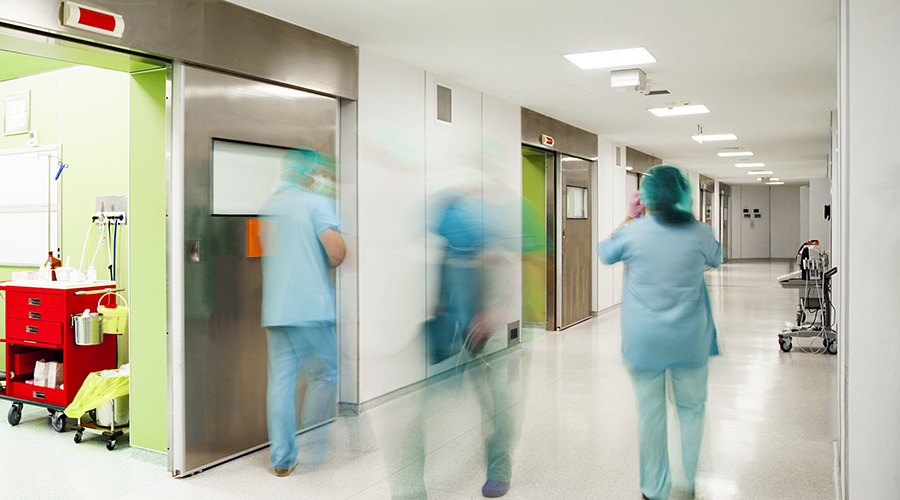To deliver capital projects in operational hospitals and other healthcare facilities is one of the most complex challenges in the construction industry. Unlike ground-up construction, these projects take place in environments where people are being cared for and lives are at stake every day.
From the project management perspective, the risks are also constantly shifting compared to ground-up hospital construction, where systems are installed in a clean-slate environment and disruption to clinical care is not a factor. Ensuring the safety of patients and staff while modernizing critical facilities requires foresight, flexibility and most importantly, communication.
Operational and stakeholder coordination
Capital projects in hospitals and other healthcare facilities involve a web of stakeholders, including administrators, clinicians, facilities teams, infection control, IT, security, patients and medical equipment managers, and each group should be given a voice at a project’s inception.
Early and consistent engagement, particularly at key design milestones such as conceptual, schematic, design development and construction documentation, helps capture concerns upfront and reduces the chance of disruptive changes later.
Once construction begins, regular project meetings ensure all parties stay aligned, with additional focus on preparing for substantial completion and operational turnover. Emergency preparedness is woven into this planning.
A health and safety plan (HASP) is developed before construction begins to set safety protocols, key contacts, evacuation routes and temporary access points. All workers and visitors receive a HASP orientation to review protocols and responsibilities in case of an emergency.
Construction phasing and logistics
Phasing is guided by a preconstruction risk assessment (PCRA), conducted with facility stakeholders to evaluate scope and potential operational impacts. The PCRA, along with infection control risk assessments (ICRA) and interim life safety measures (ILSM), provides the framework for the way construction should be sequenced to minimize risk and disruption. This process might address temporary barriers, negative air pressure, sticky mats, decontamination rooms and detailed signage, ensuring facility environments remain safe.
Disruptive work such as demolition or heavy noise is scheduled around peak hospital hours. Most hospitals require this type of work to be completed at night or on weekends, with advance communication provided to affected individuals.
In such cases, the project manager plays a critical role in coordinating schedules with clinical leadership, securing approvals from infection control and facilities teams, and ensuring contractors are prepared to adjust methods if disruptions escalate. Logistics pose additional hurdles because deliveries, waste removal and equipment staging must navigate active hospital corridors.
Related Content: Three Steps to Strategic Capital Planning
Project managers add value by pre-planning routes, budgeting for temporary protections and confirming that contractors adhere to strict timelines for cleanup and access.
Infection control and patient safety are the top priorities. Efficient construction is achieved when contractors’ methods are collaboratively reviewed against infection control and patient safety standards.
Examples of this process include tabletop reviews of construction sequencing with infection control teams, daily ICRA walkthroughs and sign-off from facilities management before high-risk activities such as ceiling work, penetrations and tie-ins proceed. By aligning approaches and maintaining a shared goal of completing the project safely, teams can keep work progressing without compromising critical protections.
Regulatory compliance and safety
Occupied hospitals and other healthcare facilities face heightened compliance requirements compared to new construction projects. In ground-up facilities, inspections often occur in a controlled, inactive setting.
But in operational hospitals, every approval — whether from the department of health, Joint Commission or local fire marshal — must be layered onto ongoing operations, requiring more documentation and coordination. Project managers ensure every notice, permit and checklist — department of health construction notices; PCRA, ICRA and ILSM approvals; and daily ICRA logs — are completed and properly addressed.
Delays in phased openings are mitigated with realistic inspection timelines and ensuring readiness. If inspection dates approach while work is unfinished, the project manager conducts a so-called pull plan to identify critical tasks and assess whether they can be completed on time. Findings are immediately communicated to stakeholders, who can adjust priorities and resources to stay on track.
Risk mitigation and contingency planning
Service interruptions are addressed through contingency planning. Backup oxygen tanks, portable HVAC units and alternate power sources are identified during preconstruction so contractors can carry costs in their bids. Project managers also coordinate with facilities teams to determine secure storage locations, whether in designated hospital staging areas or temporary trailers, so the equipment is accessible the moment it is needed.
Critical patient areas — including intensive care units, emergency departments and operating suites — are ideally kept away from construction. Where total separation is not feasible, accommodations such as rescheduling procedures during construction hours or temporarily relocating patients to alternate suites until work is complete are made so that no patient care occurs during construction activity.
Partial or phased activations require careful preparation. Clear communication with hospital leadership ensures everyone understands which spaces will be available, when and under what conditions. This foresight allows administrators to plan staff assignments and clinical operations accordingly.
Lessons and outlooks
The most important lesson to learn managing capital projects in operational hospitals and other healthcare facilities is simple but vital: Identify stakeholders, their roles and their responsibilities at the start because having them involved throughout reduces surprises and avoids costly changes.
In the wake of the COVID-19 pandemic, the demand for flexible healthcare spaces has grown, but the project manager’s role remains largely the same: Establish clear requirements at the beginning, and keep to them. For project managers new to their roles, the most important advice is to communicate openly and transparently. Overcommunicate risks, plans and updates, even to those not directly impacted, to always err on the side of caution.
Case study
Group PMX’s oversight of the Feil Family Pavilion addition at Mount Sinai South Nassau demonstrates these practices. The project required phased activation, opening lower floors while upper floors remained under construction. Extensive planning and coordination with the county fire marshal ensured the entire addition had fire suppression in place prior to occupancy.
Fire alarms, department of buildings approvals and department of health inspections for stairwells, elevators and egress routes were completed ahead of activation. Logistics sessions mapped out the way materials, equipment, and furniture would be transported while maintaining ICRA and life safety compliance.
Doubling the emergency department’s capacity added another layer of complexity. Construction was sequenced alongside a multi-phase interior renovation. The emergency department’s walk-in entrance was relocated during demolition and foundation work, while the ambulance canopy was temporarily replaced until a new structure could be installed. This work took place during off-hours, with contingency plans ready in case of emergency ambulance arrivals. When the emergency department opened, the final phases of renovation could proceed.
These efforts highlight the way pre-planning, phased sequencing and constant communication allow hospitals and other healthcare facilities to expand capacity while continuing to deliver uninterrupted patient care.
Michael Kimura, P.E., CCM, is director for life sciences and healthcare at Group PMX.

 Making the Energy Efficiency Case to the C-Suite
Making the Energy Efficiency Case to the C-Suite How to Avoid HAIs This Flu Season
How to Avoid HAIs This Flu Season Design Phase Set to Begin for Hospital Annex at SUNY Upstate Medical
Design Phase Set to Begin for Hospital Annex at SUNY Upstate Medical Building Hospital Resilience in an Era of Extreme Weather
Building Hospital Resilience in an Era of Extreme Weather Ennoble Care Falls Victim to Data Breach
Ennoble Care Falls Victim to Data Breach